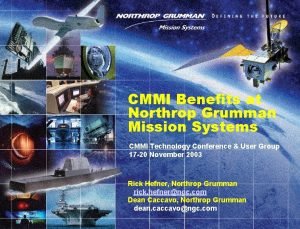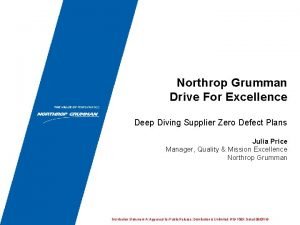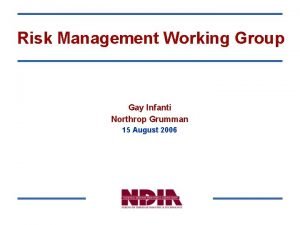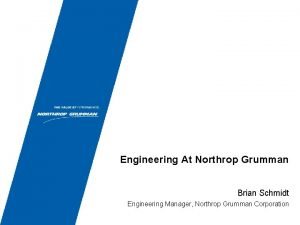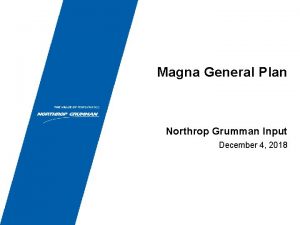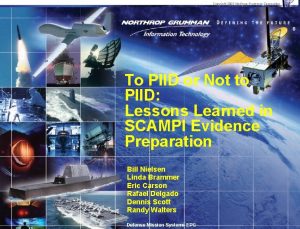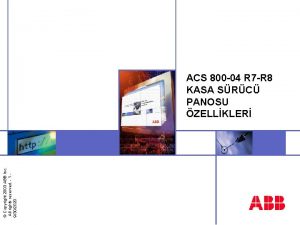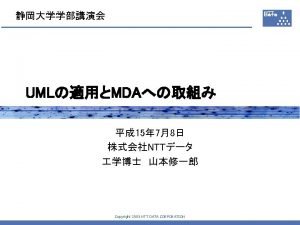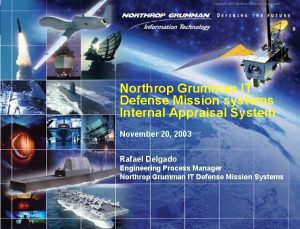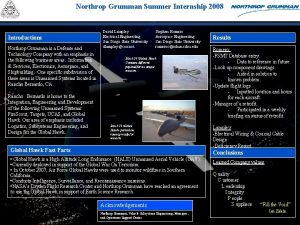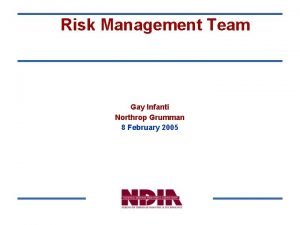Copyright 2003 Northrop Grumman Corporation 0 To PIID
















- Slides: 16

Copyright 2003 Northrop Grumman Corporation 0 To PIID or Not to PIID: Lessons Learned in SCAMPI Evidence Preparation Bill Nielsen Linda Brammer Eric Carson Rafael Delgado Dennis Scott Randy Walters Defense Mission Systems EPG

Copyright 2003 Northrop Grumman Corporation 1 Topics § § Background SCAMPI Evidence Collection Approach SCAMPI Evidence Tracking Approach Results and Lessons Learned

Copyright 2003 Northrop Grumman Corporation 2 Background § Defense Mission Systems (DMS) is a business unit of Northrop Grumman Information Technology § Formed in June 2001 from 7 legacy organizations with different processes that were reformed using one Integrated Enterprise Process § Approximately 5, 700 employees § In December 2001 DMS conducted a vendor-led CMM SCE that confirmed CMM Level 3 § Began transitioning to the CMMI in 2001 § Verified CMMI-SE/SW Level 3 via internal appraisals in December 2002 § 2003 goal was to achieve CMMI-SE/SW Level 5 § A vendor-led SCAMPI planned for November 2003 § Readiness review planned for September 2003 § Four geographically dispersed projects were selected to undergo this appraisal § From mid-May to mid-September 2003 objective evidence (OE) was collected, reviewed, and organized by the projects and the EPG

Copyright 2003 Northrop Grumman Corporation 3 Key SCAMPI Dates and Objectives CMMI SE/SW Scope Readiness Review Formal Appraisal SCAMPI Team Maturity Level 5 Sep 22 – Oct 3, 2003 Nov 3 – Nov 13, 2003 3 SCAMPI vendor 5 DMS EPG § Readiness review § Objectives § Review and assess evidence for meeting ML 5 CMMI goals § Output – Determine if formal appraisal should be conducted per plan § Formal appraisal § Objectives § Formally evaluate evidence and perform staff interviews to formally assess whether or not CMMI goals are satisfied § Output – Assign Maturity Level rating

Copyright 2003 Northrop Grumman Corporation 4 Objective Evidence Collection Approach DMS EPG Action Project Response Prepare Practice Implementation Indicator Descriptions (PIIDs) templates, and provide orientation on evidence requirements for each process area § Locate best evidence § Document evidence on PIID templates § Provide evidence electronically Review evidence and PIIDs for applicability to CMMI practices and provide comments back to projects Respond to reviewer comments and update PIIDs/OE Conduct re-reviews as needed until all evidence is satisfactory Respond to reviewer comments and update PIIDs/OE

Copyright 2003 Northrop Grumman Corporation 5 Objective Evidence Collection Approach (cont. ) § Weekly one hour Net. Meetings were held between EPG and projects to § Review progress § Orient projects in CMMI Process Areas (PAs) due the following week § Projects initially assigned to complete PIIDs/OE for two CMMI PAs per week § When this rate proved to be unachievable, a new schedule was prepared § One PA per week § Readiness review and formal appraisal were delayed by six weeks

Copyright 2003 Northrop Grumman Corporation 6 PIID Example SPs for Configuration Management (CM) PA From SEI Populated by Project Populated by Reviewer From SEI

Copyright 2003 Northrop Grumman Corporation 7 PIID Preparation Guidance Given to Projects

Copyright 2003 Northrop Grumman Corporation 8 Evidence Collection Indicators § Good measurements are needed to track the collection of PIIDs and OE § 17 PAs (34 PIID files) for each project through level 5 § 334 practices (with associated direct and indirect evidence) through Level 5 for each project § 91 practices for organization PAs § Total of 1, 427 practices to be documented § Our tracking approach used earned value methods and quantitative measurements § Defined a collection process with 4 steps (including 2 reviews) and assigned a weight to each step § Evaluated status of each project at the practice level each week § Used a spreadsheet to aggregate results and graph progress against the plan

Copyright 2003 Northrop Grumman Corporation 9 Project PIIDs/Objective Evidence Status Measurement

Copyright 2003 Northrop Grumman Corporation 10 PIIDs/OE Overall Summary Measurement

Copyright 2003 Northrop Grumman Corporation 11 PIIDs/Objective Evidence Status as of 9/22/03

Copyright 2003 Northrop Grumman Corporation 12 Evidence Collection Results § Evidence collection was behind schedule up to the last week before readiness review § Project conflicts restricted availability of key people § Limited number of EPG reviewers to keep up with the stream of PIIDs/OE to be reviewed § Each set of PIIDs/OE (e. g. , all SPs for a PA) typically took 2 to 4 hours for a thorough review § As the readiness review approached, EPG reviewers worked directly with projects to complete the PIIDs/OE rather than sending comments back to projects for another cycle of changes and review § Should have used this approach earlier § 100% of PIIDs/OE were reviewed and in place for the readiness review § Required significant overtime from both EPG and projects

Copyright 2003 Northrop Grumman Corporation 13 SCAMPI Readiness Review Results § All PIIDs/OE were evaluated by the team § Some issues were identified and corrected § By the end of the readiness review, all OE had been appraised as fully satisfying CMMI practices through Level 5 § Formal appraisal scheduled to be conducted as planned Formal SCAMPI appraisal completed 11/13/03 CMMI Level 5 Achieved!

Copyright 2003 Northrop Grumman Corporation 14 Lessons Learned § Treat the readiness review as though it were the formal appraisal § Increases up-front effort, but reduces surprises § Provide detailed presentations on organization and project processes and status § Information can serve as affirmations for numerous practices § Be prepared to invest a lot of effort in PIIDs and Objective Evidence (OE) § SCAMPI is verification rather than discovery, which increases the importance of OE § Detailed PIIDs smooth the appraisal process § Don’t expect project staff to understand the PIIDs without EPG guidance and training § Standardize PIID organization, format, default contents, and file organization early to reduce rework § Provide sample completed PIIDs to the projects including references to organizational policies and processes § Supplement electronic evidence with hard copies of the PIIDs for the readiness review and formal appraisal

Copyright 2003 Northrop Grumman Corporation 15 More Lessons Learned § PIIDs/OE Considerations § PIIDs and OE constitute a very large amount of material (e. g. , 5, 700 files), so use good project practices for version tracking and control § Get projects to focus on satisfying the practices and not overwhelming with evidence § Decide when the evidence is “good enough”and establish a baseline – otherwise some engineers will refine the OE or the PIIDs indefinitely in search of “perfection” § Summary § Treat the SCAMPI like a project, and use all of your best practices for planning, training, evaluating, and tracking § Capitalize on PIID preparation investment by retaining the records and consider keeping records current for use on future SCAMPIs § Consider using interim appraisals to build up OE over time and using automated tools to generate PIIDs from interim appraisal data § Avoid the crunch prior to a SCAMPI
 John russell northrop grumman
John russell northrop grumman Madl data link
Madl data link Northrop grumman mission systems organization chart
Northrop grumman mission systems organization chart Northrop grumman suppliers
Northrop grumman suppliers Northrop grumman
Northrop grumman Northrop grumman webmail
Northrop grumman webmail Northrop grumman amherst systems
Northrop grumman amherst systems Northrop grumman
Northrop grumman Northrop grumman bacchus
Northrop grumman bacchus Piid cmmi
Piid cmmi Grumman aircraft engineering corporation
Grumman aircraft engineering corporation Copyright 2003
Copyright 2003 2008 pearson education inc
2008 pearson education inc Copyright 2003
Copyright 2003 Copyright 2003
Copyright 2003 Northrop
Northrop Northrop frye archetypes
Northrop frye archetypes


